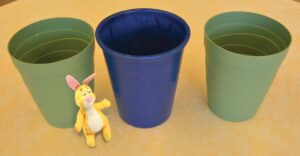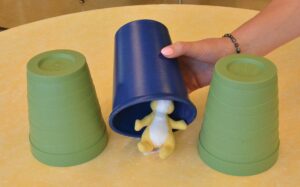Executive function
Toddlers watch a caregiver play a memory game with a toy rabbit.




Be Prepared: The toy rabbit should be able to fit fully under each of the pots. The pots can be different sizes and colors, if you wish. Use baskets if pots are not available.
[Invite 3–5 toddlers to join you for a game. Show the toy rabbit and flower pots with openings face up.]
 Our toy rabbit likes to hop around and hide. Please help me watch the rabbit hop, hop, hop and then remember where the rabbit is hiding.
Our toy rabbit likes to hop around and hide. Please help me watch the rabbit hop, hop, hop and then remember where the rabbit is hiding.
We can pretend we are in a garden and these are empty pots for flowers. Rabbits like to visit gardens because there are good things to eat and fun places to hide in a garden.
There are lots of things to watch in our room. Right now we want to use our eyes to watch the rabbit hop around and hide. We want to remember where the rabbit is hiding.
[Turn the three flower pots upside down and place them in a row so toddlers can see each pot.
Hop the rabbit around on the floor, always in front of the toddlers, and on top of the flower pots for a few seconds. Remind toddlers to keep watching the rabbit. While toddlers are watching, place the rabbit under the middle flower pot. Intentionally look elsewhere when you hide the rabbit.]
 Oh, no! I looked at something else in our room when our rabbit went under a pot.
Oh, no! I looked at something else in our room when our rabbit went under a pot.
The rabbit hopped under a flower pot. The rabbit is hiding. But I am not sure where the rabbit is hiding!
[Look under the right flower pot, then the left. Have fun pretending you did not pay attention to where the rabbit hopped. Show excitement when you find the rabbit under the middle flower pot!]
I did not remember where the rabbit hid because I did not always keep my eyes on the rabbit. I watched something else when the rabbit hid under a pot.
The rabbit is going to hop, hop, hop and then hide again. This time I am going to watch closely and try to remember where the rabbit hides.
[Hop the rabbit on the floor and on top of the flower pots, always in full view of the toddlers. Hide the rabbit under the left or right flower pot.]
The rabbit hopped under a flower pot. He is hiding from us again!
This time I can remember where the rabbit is hiding because I watched the rabbit all the time. I did not look at something else. I kept my eyes on the rabbit.
I remember the rabbit is hiding under this flower pot.
[Point to the correct flower pot. Invite a toddler to lift the pot to reveal the rabbit. Lead toddlers in expressing excitement about remembering where the rabbit was hiding.]
We played a game of watching our toy rabbit hop around and then hide. I could not remember where the rabbit was hiding the first time it went hopping. Why? (did not watch the rabbit at all times) There are neat things to look at in our room. It is easy to pay attention to something else. But the second time our rabbit went hopping, I watched the rabbit all of the time. I remembered where the rabbit was hiding because I paid attention to the rabbit.
Executive function
A toddler plays a game of watching and remembering where a toy rabbit is hiding.




Be Prepared: The toy rabbit should be able to fit fully under each of the pots. The pots can be different sizes and colors, if you wish. Use baskets if pots are not available.
Invite one toddler to play a memory game with a toy rabbit. Explain that the toy rabbit likes to hop, hop, hop and then hide under a flower pot. Encourage the toddler to pretend we are in a garden. Rabbits like to visit gardens because there are good things to eat.
Explain that in our game we watch the rabbit hop around and then remember where it is hiding. Place the three pots upside down in a row or in a different configuration if you anticipate the toddler is ready for slightly more challenge.
Hop the rabbit around and, while the toddler is watching, place the rabbit under a pot. Invite the toddler to lift the pot where he/she remembers the rabbit is hiding.
Describe the toddler’s actions and provide verbal support as appropriate. Play the game again if the toddler shows interest. Consider the Enrichment tip suggestions for adding challenge to the activity.
Conclude the activity by emphasizing how the toddler worked to watch and remember.
Executive function
Two toddlers take turns watching and remembering the location of a toy rabbit as part of a memory game, with caregiver support.




Be Prepared: This activity is for toddlers who readily participated in Option 2. The toy rabbit should be able to fit fully under each of the pots. The pots can be different sizes and colors, if you wish. Use baskets if pots are not available.
Invite two toddlers to join you to play a memory game with a toy rabbit that likes to hop around and hide. Remind toddlers of how the game works. Emphasize the importance of watching the rabbit at all times and remembering where it hides. Explain that the two toddlers will take turns. One toddler will hop the rabbit around the area (a pretend garden, as described in Options 1 and 2) and hide it under a flower pot. The other toddler will watch and try to remember where the rabbit hides. Then toddlers reverse roles.
Play the game for two rounds (each child does the hopping or finding twice). Provide verbal support as appropriate. Facilitate turn-taking. Offer a third round if both toddlers seem interested. End the activity by reminding toddlers that we worked hard to watch and remember where the rabbit went.
This is one of several activities for older toddlers (24–36 months) that use a simple memory game to promote executive-function skills. These skills include paying attention (watching) and holding onto and using information (remembering). Executive function also involves inhibiting natural thoughts and responses that are not helpful to the situation. In Option 1, for example, the caregiver demonstrating how to play the game looks away from the toy rabbit briefly and explains that looking elsewhere makes it impossible to know where the rabbit is hiding. In a second round of the game, the caregiver works hard to watch the toy rabbit. Similar activities are offered in Blocks 3 and 12, each with a different set of materials.
Look for ways to provide support to both toddlers who participate in Option 3. The experience of moving and hiding the rabbit is as important as watching and remembering. Incorporate supports suggested in Option 2 if toddlers find Option 3 to be too difficult. Taking turns is generally a new experience for older toddlers and your guidance in Option 3 is especially important. Describe both roles when you announce a new turn. Example: “Now it is Samantha’s turn to make the toy rabbit hop and hide. It is Julian’s turn to watch the rabbit and remember where the rabbit is hiding.”
Toddlers differ in the ease or difficulty of developing executive-function skills. Toddlers who are at a beginning level of watching and remembering may benefit from repeated participation in the game through Options 1 and/or 2.
It may be tempting to use the activity as a guessing game by encouraging toddlers to not look when the rabbit hides. A guessing game does not promote short-term memory skills, however. Avoid using the word “guess” as part of the activity, such as saying “make another guess” if a toddler does not select a correct pot. Instead, lift the pot to reveal the rabbit and try another round.
Toddlers who are familiar with the story of Peter Rabbit (Optional Reading) may enjoy having the game introduced in relation to Peter Rabbit hopping around the garden and hiding from Mr. McGregor.
Extra support
Enrichment
Materials Needed: sensory table, several toy rabbits, several flower pots and other containers, shredded paper for pretend grass
Invite several toddlers to play at the sensory table with materials described above. Encourage them to hide the rabbits (while their peers are watching) under the pretend grass, flower pots, or other containers for their peers to find.
Materials Needed: Tale of Peter Rabbit by Beatrix Potter
Read the book with children in your care prior to offering Option 1 or 2 to toddlers. Help toddlers and preschool-age children connect the game to the story of Peter Rabbit hopping around the garden and hiding from Mr. McGregor. Preschool-age children may enjoy hopping and hiding the toy rabbit in Options 1 and/or 2. Babies may enjoy holding a toy rabbit during any of the option activities.